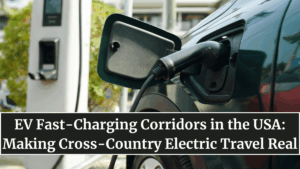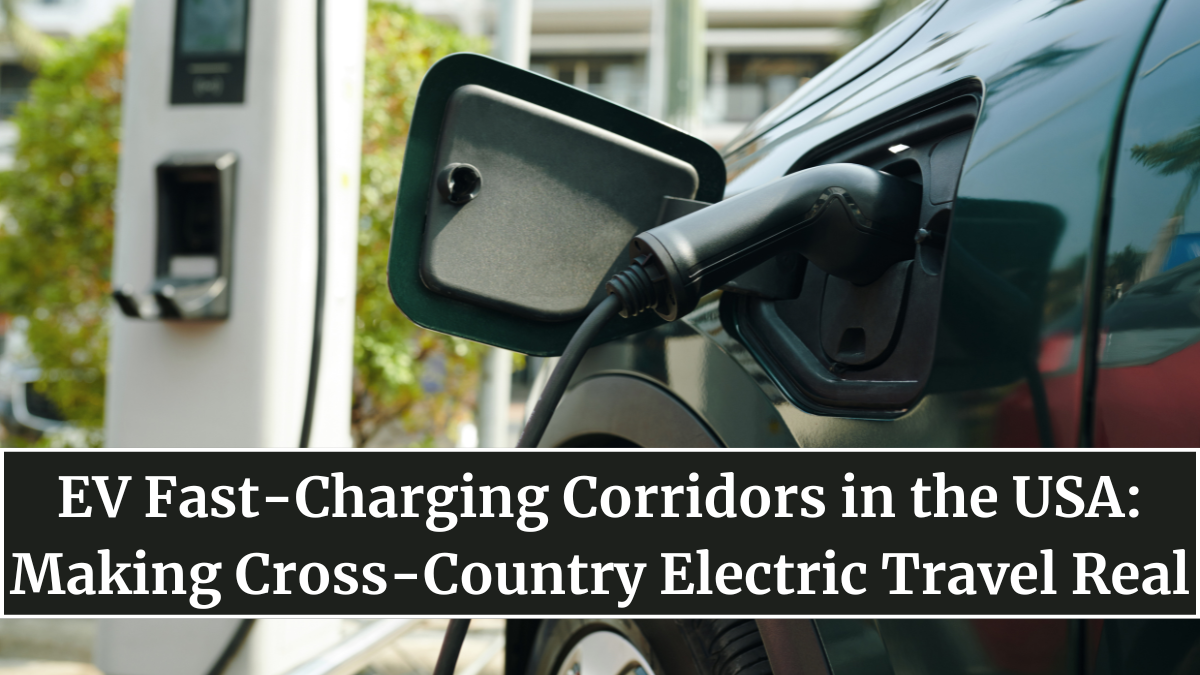A few years ago, taking a cross-country road trip in an electric car sounded ambitious — today, it’s becoming effortless. The USA highway EV fast-charging corridors initiative is transforming the way Americans travel, connecting cities, states, and coastlines through a web of rapid EV chargers. What was once limited to short commutes is now enabling families, truckers, and adventurers to traverse the nation without worrying about running out of charge.

America’s Electric Highway Vision
Under the National Electric Vehicle Infrastructure (NEVI) program, the U.S. government has committed billions to building an EV fast-charging network spanning major interstate highways. The goal is simple but transformative: install fast chargers every 50 miles along designated corridors covering more than 75,000 miles of highways.
This network ensures that from California to New York or Texas to Chicago, drivers can rely on consistent, standardized charging infrastructure. It’s a monumental step toward making EVs as convenient as gasoline cars — if not better.
Key States and Routes Leading the Charge
Several U.S. states are already ahead in deploying charging infrastructure. Here’s how the rollout looks across the nation:
| Corridor / Region | Key States | Network Partners | Highlights |
|---|---|---|---|
| I-5 Pacific Corridor | California, Oregon, Washington | Electrify America, EVgo | 200+ fast chargers connecting West Coast cities |
| I-95 East Coast Corridor | Florida to Maine | Tesla Supercharger, ChargePoint | Serves high-traffic urban and suburban zones |
| I-10 Southern Corridor | California to Florida | Shell Recharge, Blink | 2,400-mile route through 8 states |
| I-80 Midwest Corridor | Nevada to New Jersey | Rivian Adventure Network | Focused on long-haul and commercial fleets |
| I-70 Mountain Corridor | Colorado to Missouri | ChargePoint, state partnerships | Supports high-altitude and cold-weather charging |
With over 500,000 public chargers planned by 2026, the U.S. is moving toward a future where EV travel becomes the default, not the exception.
How Fast-Charging Corridors Work
Unlike regular charging stations, fast chargers (DC chargers) deliver power at 150–350 kW, restoring 80% of battery capacity in 20–30 minutes. Many of these new stations are being equipped with amenities like rest areas, Wi-Fi, cafes, and solar roofs.
The U.S. Department of Transportation (USDOT) and private operators are collaborating to standardize plug types — particularly the new NACS connector (used by Tesla) and CCS format, ensuring all EV models can charge seamlessly at any location.
Impact on Long-Distance Travel and the Economy
The establishment of EV corridors is doing more than eliminating range anxiety; it’s reshaping the American road trip economy. Towns along major highways are witnessing an influx of EV travelers who stop to recharge, eat, and shop — fueling local businesses.
It’s also driving growth in logistics electrification. Fleet operators like Amazon, FedEx, and UPS are already leveraging corridor infrastructure to plan electric delivery routes efficiently. With predictable charging access, commercial EV adoption is expected to grow by over 50% by 2027.
Challenges in Implementation
Building a nationwide network comes with its share of hurdles. Power grid stability, charger reliability, and interstate coordination are key challenges. Some regions, especially in rural America, lack the electrical infrastructure needed for high-capacity chargers.
To overcome this, utilities are investing in grid modernization and renewable integration, while companies are experimenting with battery storage-based charging stations to reduce grid load. The NEVI plan also includes funding for maintenance and workforce training, ensuring these stations remain operational long-term.
The Road Ahead for America’s EV Highways
By 2030, the U.S. aims to have a fast charger within 50 miles of 97% of all drivers. As more automakers transition to electric lineups, highway corridors will be crucial to sustaining EV growth.
The next phase involves smart charging integration — using AI to predict charger demand and balance energy distribution. Coupled with renewable energy sources like solar and wind, America’s electric highways are becoming a model of sustainable infrastructure.
Soon, driving coast-to-coast without burning a drop of fuel won’t be a futuristic dream — it will be the new American tradition.
FAQs
What is an EV fast-charging corridor?
It’s a network of high-power EV chargers installed along highways, allowing drivers to recharge quickly during long-distance trips.
How fast can these chargers power an EV?
Most DC fast chargers can charge up to 80% of a battery in 20–30 minutes, depending on vehicle capacity.
Who is building the U.S. EV corridor network?
The initiative is led by the U.S. Department of Transportation (USDOT) under the NEVI program, in partnership with companies like Tesla, ChargePoint, and Electrify America.
Will all EVs be compatible with corridor chargers?
Yes. The U.S. is adopting universal plug standards (CCS and NACS), ensuring compatibility for nearly all modern EVs.
How will EV corridors affect gas stations?
Many traditional gas stations are transforming into multi-energy hubs, offering both EV fast-charging and fuel options side-by-side.
Click here to know more.
